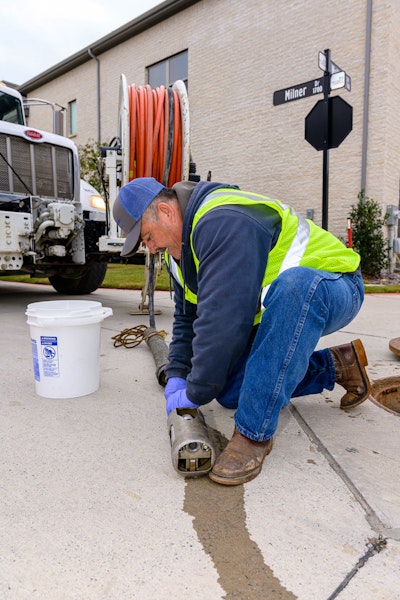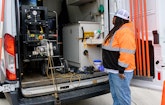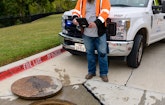
The Plano Wastewater Department staff includes (from left) Chris Stanton, utility compliance superintendent; Juan Mendoza, crew leader and jet truck operator; Blake Tessem, crew leader; Abby Owens, strategic planning and compliance manager, Delbert Kleppe, crew leader and CCTV truck operator, Daniel Prendergast, director of public works; Albert Trevino, maintenance worker; Justina Sylvester, crew leader and CCTV truck operator; and Jacob Gadbury, preventive maintenance supervisor.
Interested in Infrastructure?
Get Infrastructure articles, news and videos right in your inbox! Sign up now.
Infrastructure + Get AlertsThe Plano (Texas) Public Works Department illustrates particularly well how a proactive approach to effective management can impact day-to-day and year-by-year operations.
Abby Owens is the department’s strategic planning and compliance manager. During her four years in that role, Owens has helped implement a comprehensive upgrade in the department’s sewer management protocol by implementing sound asset management practices that shifted the department’s efforts from a reactive to a proactive approach.
With respect to the sewer system, the first step in changing the approach was adopting a CMOM plan in 2017.
“CMOM provided the roadmap for our efforts to inspect and maintain our collections system, which included determining the condition of our assets and prioritization of sewer lines and manholes,” Owens says. “Then we worked to develop a master plan to identify capacity needs and direct our inspection and replacement work toward the most critical assets.”
The Cartegraph work order and asset management system was fully operational in the Plano department in 2018 after several years of incremental introduction. In 2020, sewer inspection data was integrated from GraniteNet software, which utilizes condition-based data to score pipelines. After assimilating the data, Cartegraph provides a ranking of assets that is used to develop a prioritization plan for scheduled pipe rehabilitation or replacement.
“Before Cartegraph, crews didn’t have a uniform and organized way to track pipe inspection data,” Owens says. “The reports were not geospatially referenced so supervisors would have to read page by page and then look up pipe IDs to figure out where a defect was located. It was also difficult to log when repair work was completed. Cartegraph gave us the ability to log both inspection and repair work and tie the information to the sewer main asset. Now we have a full history of inspection and repair which allows us to better understand our system and take a proactive approach with directing our work.”
The asset management software and correlated systems proved to have a consequential impact on the city’s sewer system. It improved the utility’s awareness of infrastructure condition, changed manpower assignments and equipment usage, and made expenditures more cost effective.
Owens says the most singular benefit was “increased operational efficiency with a proactive approach. We previously didn’t have a plan of operation or prioritization for inspection. Now our TV trucks inspect areas based on criticality. We are able to catch problems sooner and direct our rehab efforts to priority areas. Operational efficiency is definitely the biggest benefit.”
Verification
Through the use of asset management tools and coordinated planning, supervisors are able to direct the department’s TV inspection vans to priority areas that were rarely visited, and some surprising information came to light. Assumptions about the condition of pipe have proven wrong in some cases.
“We had a sewer line that, according to our GIS data, was clay and installed in the 1970s. We expected it to be in failed condition,” Owens says. “When we inspected it, we found that not only was it was not on the verge of failing, it was in great condition. So, after importing the inspection score, instead of showing up as a zero, the pipe now shows as a 95.”
How could something like that happen? “Most of the time, a clay pipe installed in the ’70s would be in poor condition. But this particular pipe didn’t experience the same wear and tear that we had assumed,” she says.
In another surprise, a vintage clay pipe was presumed to be in a nearly failed state. However, when the TV crew inspected the pipe, they discovered that it had been lined at some unknown point in the past. “So, now we know and can update our records to better understand our system’s condition.”
New approach
The city has over 1,000 miles of sewer main. The systematic exploration of all that underground infrastructure must be done in a smart way to stay ahead of problems. In prior years, the department relied on sheer volume of inspections to keep managers abreast of pipe condition, but that approach didn’t always pan out.
Owens says inspection crews were directed to “focus on footage, to get lots of pipe visually inspected.” Consequently, TV crews would focus on the pipes that were easiest to inspect. Unfortunately, this often meant PVC pipe that was relatively new and of low priority concern was inspected. “Our focus was on footage rather than understanding problem areas. Since the shift, we have seen a slight decrease in footage completed each month, but we are gaining valuable knowledge of the real condition of our sewer mains.”
The videos of sewer mains are shot with an assortment of cameras. JetScan (Envirosight LLC) and RedDawg video units are used on jetter lines during cleaning to capture quick scans of lines. CUES MPlus push cameras record what’s happening inside residential lateral lines during customer service calls and CUES OZIII units provide CCTV operators a view of the interior of mainlines during inspections.
The department is halfway through accumulating data on pipe 12 to 48 inches in diameter, with the contractor to complete all lines by next May. In addition, some 80% of Plano’s 15,300 manholes have been inspected, and about 45% of 4.6 million linear feet of smaller diameter pipes have had cameras run through them.
“In April 2021, we built a filter in Cartegraph to direct our TV crews to areas most in need of inspection,” Owens says. “Of 825 segments of smaller diameter pipe to be inspected, we’ve completed inspections on 25%.”
Focused maintenance
The inspection routine wasn’t the only activity impacted by implementing Cartegraph. Smarter data collection and goal setting also impacted the cleaning side. “Before Cartegraph, we didn’t have a clear picture of which lines were being cleaned when we calculated total footage. Through better work order management, we can track our cleaning to ensure we get to all lines every five years,” Owens says. “We learned that we had way more cleaning going on than we really needed to achieve that goal.”
That realization led to the department routinely rolling out two vac trucks each day instead of three. Vac-Con full-sized trucks are the mainstay units. A midsized PipeHunter sewer cleaning unit rides a Freightliner chassis into areas harder to access and a smaller PipeHunter jetter is mounted on a Hino truck for residential services and light cleaning.
Besides cutting truck operating costs by one-third, the reduction in vac activity meant that the water-sewer preventive maintenance staff could be reorganized. “We have struggled to stay fully staffed, like many other public works departments, and this let us prioritize work to focus efforts.”
Instead of dedicating employees to the same role each day, crews cross-train and rotate through the different roles, including flushing dead-end mains and inspecting and maintaining valves.
The department crews do their own spot-repairing of sewer infrastructure, which includes point repairs and service line repairs. Contractors are hired to handle any cured-in-place lining projects, pipe replacement or installation of new lines.
The cost side of operations was positively impacted by the more effective management of people and equipment. Plano draws on its revenue and capital accounts to fund major rehab and replacement undertakings, spending about $20 million on such capital investments in 2021, a projected $18 million in 2022. This consistent investment in sewer infrastructure has provided staff with the resources to maintain such a vast collections network.
Value
Owens says the adoption of the asset management software has been well received by department crews, even though it came with a learning curve.
“We conducted trainings with employees and meet them where they are for training needs,” she says. “We have found over the last few years that employees like having goals and knowing where we are as a department and how their work can help us reach a goal.”
The younger team members also like the iPads they were given to use in the field as compared to the old paperwork order system. Some employees struggled to learn the new technology in the beginning, but with training and support, they’ve found the value that Cartegraph adds — especially after hours when trying to locate an asset.
Through improved operations and the implementation of Cartegraph, Plano is ahead of the game.
“We’ve been able to provide a better level of customer service as well,” Owens says. “We are able to track customer service calls and compare them with inspection data and cleaning history to identify potential areas for improvement. Providing excellent customer service is important for us while maintaining high levels of service.”













